The Mother of Big Brother
Imagine walking out the door, and knowing every single action, movement, sound, micro movement, pulse, and thread of information is being tracked, monitored, stored, analyzed, interpreted, and logged. The world we will live in seems to be a much bigger brother than the Orwellian vision, its the mother of big brother.
Can we use new technologies to imagine a world where we are liberated and empowered, where finally all of the technology becomes more than gimmick and starts to actually work for us or are these technologies going to control us, separate us, divide us, create more borders. Will the securitzation of city space create digital borders that monitor our movement and charge us for our own micro movements inside the system.
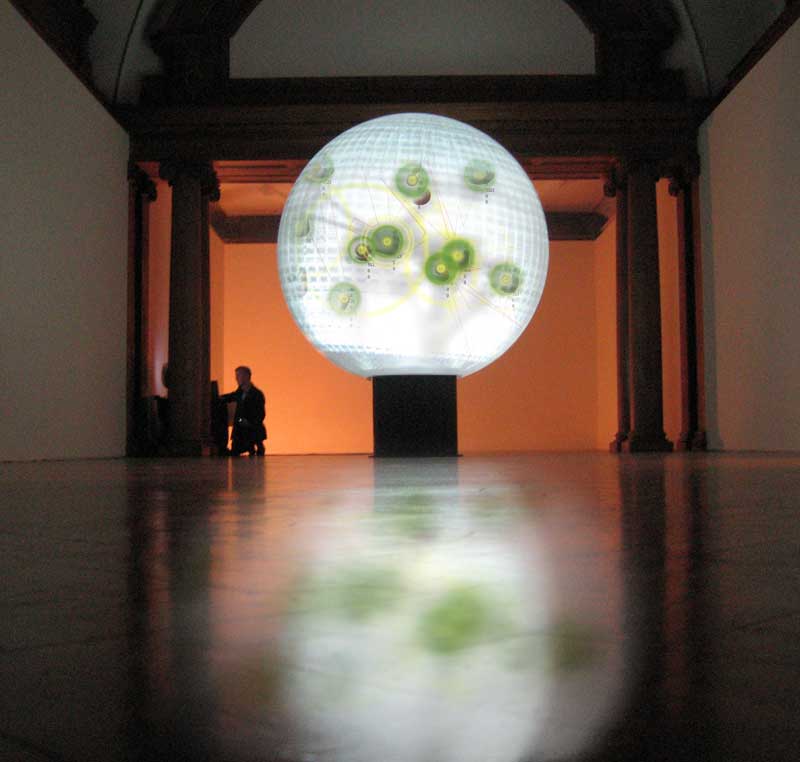
Image by Stanza / Sensity on a round globe display tested at County Hall London (Live data on globe 2006)
Real time.
There is a argument to opening up the level of control and responsibility in the system. It is a good argument until something changes, the passwords change, the building goes private, and every single piece of data is used for something that it wasn't intended for. Some things change for the better but sometimes they don't; one thing is for sure; things change.
My focus is on the things that change, the flow, the data that describes our experience of the city as space. Data from all sides in systems that can be mediated by all, with varying visualizations communicated over the internet and represented onto different display systems. Recurring themes throughout my career include, the urban landscape, surveillance culture and alienation in the city. I am particularly interested in real aspects of the city. Although there are theoretical aspects to my work my works is practise based……in other words I make stuff. It is through this process of research that I find my next questions.
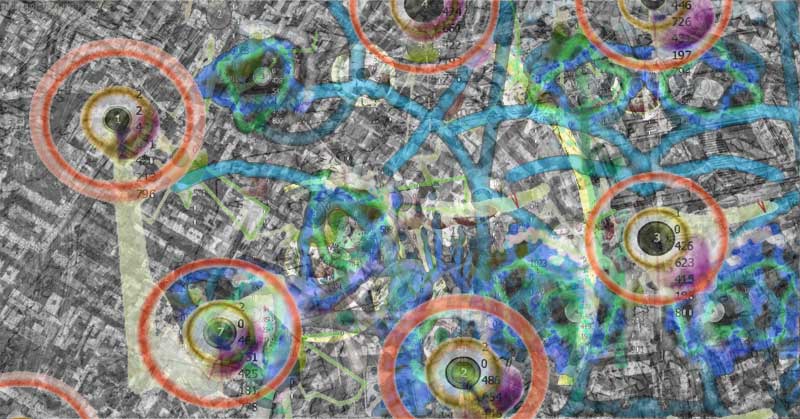
Image by Stanza / Above image shows xml data from London and Copenhagen mashed up together to form a mixed merged city space. Stanza 2008
My wireless sensor networks are set up to visualize cities as 'worlds' full of data, a city of bits. These new data-spaces can help us understand the fundamentals of our outside environment.

Image by Stanza
In Sensity I have visited ten world cities and made visualisations. This artwork is made from data that is collected across the urban and environment infrastructure ie from the city. My aim is to re-engage with the urban fabric and enable new artistic metaphors within city space. The sensors are positioned across the city. Custom made software now enables these sensors to communicate will one another in a network over a proxy server in real time. Control to the hardware is opened up. The data is then turned into online real time visualizations of the space.
This work opens up a discourse about networks and surveillance technologies. The ownership and interrogation of public domain space is opened out where anyone can view all the data in these networks. This work aim to reclaim the city which is remade as a real time virtualised space belonging to all.
Sensity can also be shown / exhibited as an installation and projected ie, making a display based on the net based interfaces using the data collected. Sensity can also installed permanently for a longer period in rural or urban space.
The changing data is what affects what you see and experience. The flash interfaces reflect these real time changes in the interactive city space. This is open source so other academics, urban designers, researchers as well as artists can make use of the data. The sensors monitor temperature, sounds, noise, light, vibration, humidity, and gps. The outputs from sensors are also visable on google maps. The social space is opened up into a real time flow space, a new virtualized data space emerges. see http://www.soundcities.com/data.php
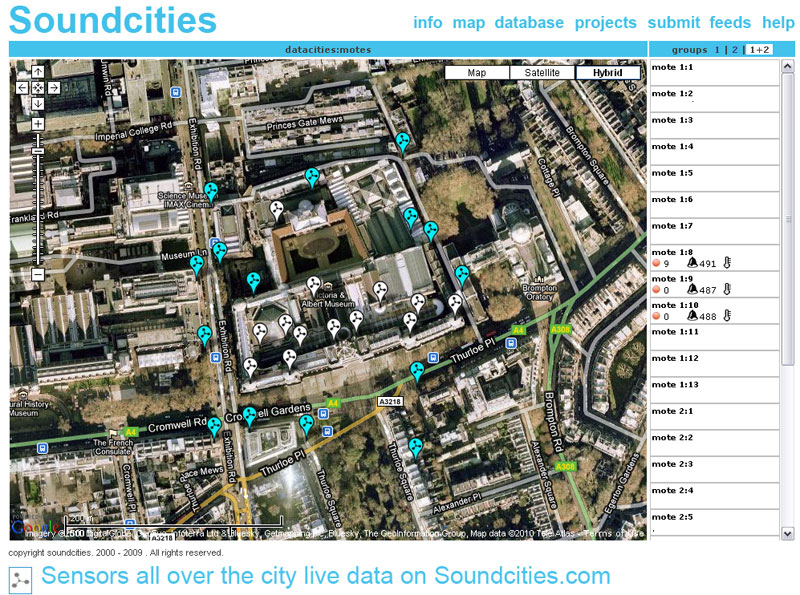
Image by Stanza
Stanza Artworks using urban sensors.
House
A dynamic public sculpture viewable over the internet. House describes the space, a real Victorian terraced house, in this case, that the artist lives in. In “House”, the private interior has been made public. The sensor data unfolds and discloses the inherent properties of the space, creating an online artwork visualisation. The environment is disclosed and made public opened up and made transparent.
Gallery
Gallery describes the space, in this case the upper gallery in Plymouth Arts Centre, England. Made during an artist in residency project in situ in the gallery space during feb 2008. "Gallery", is part of a series of process led experiments in data visualization within the context on an art gallery. Stanza asks, "what happens during the process of visiting the gallery as a dataspace"; ie what happens to the gallery and what do the visitor do? The gallery laid bare as a work of art. Gallery proposes that the data is art. The art is a real time flow of the things around us that allow our senses to invoke understanding. The gallery space becomes the art described by the shifts in light, temperature and noises in the space over time.
Field. Tree. Park. Lake.
A series of sonifications and visualisations of landscapes. The landscape becomes virtual, dynamic, and encoded. I am trying to disclose the underlying data that we see that is changing all the time in front of us. The sounds you hear are streams of data acquired and processed in custom made software from thirty motes sensors; this is changed into sounds. The squiggles or painterly stuff on the image is a response to the changing light, temperature, noise, humidity and pollution of the landscape....which is also fixed by its gps position.
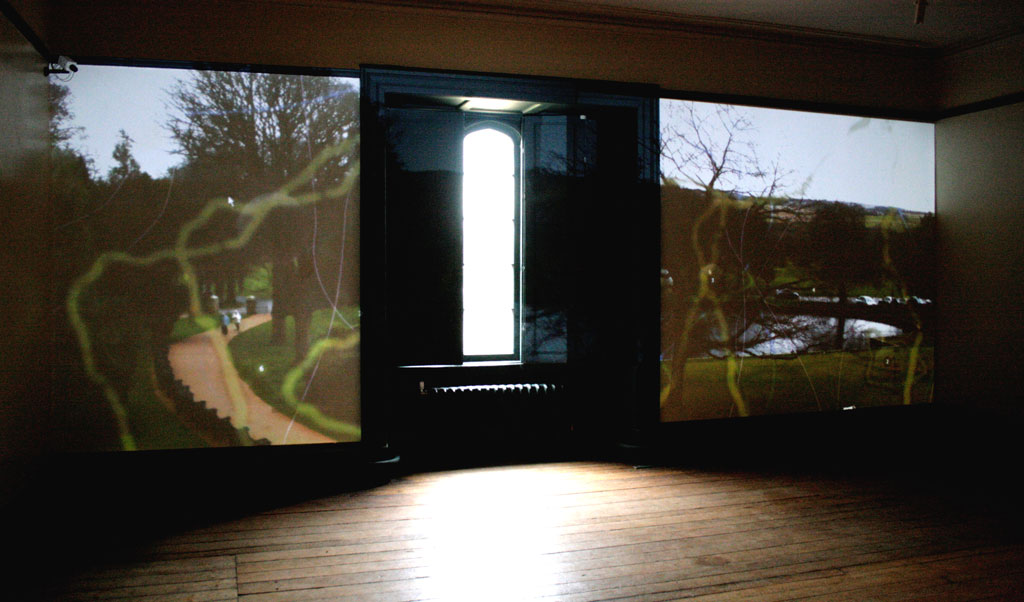
Image by Stanza
Sonicity.
Sonicity is a responsive installation, a sonification of the space. The system monitors the space (the building) and the environment (the city) and captures live real time data ( light , temperature, noise, humidity, position) to create an ambient sonification, an acoustic responsive environment, literally the sound of the micro incidents of change that occur over time. The interactions of all this data are re-formed and re-contextualised in real time as a audio experience. Hundreds of small speakers are wired together and an installation is made across the available space.
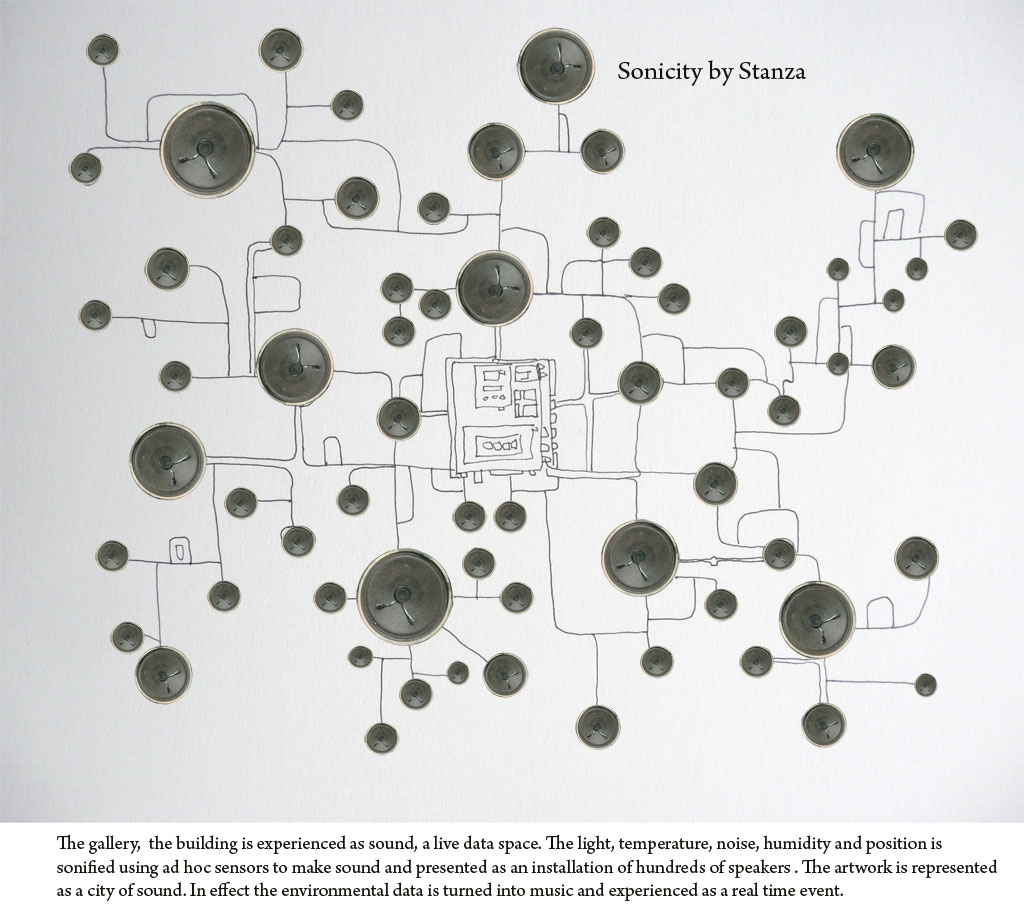
Image by Stanza
Capacities.
An installation responding to changes in the environmental data. There are electronic components all over the floor. (Fans, Lead, Soleniods, Motors) these move only in response to a wireless sensor network of 40 motes deployed in the gallery and across the environment. The light temperature, noise, humidity of the space and the city. As this data changes this wired city changes. That is the physical world is made virtual and them made real again. IE fans turn when the temperature changes, motors turn when the light changes. This whole piece is a living and breathing city. The real city captured made virtual and made real in another form.

Image by Stanza
Facade.
An interactive responsive architecture linked to the culture of the AOF Nova building within the city of Trondheim, Norway. The objective is for the Nova building to become the focus and the centre of a new social space harvesting data and information from across the city. The facade presents the emotional real time state of the city by using live data and CCTV images to represent the Nova Building as a living breathing entity. Using custom made software the artist will interpret the data collected into the artworks that are incorporated into the display. Exciting use of the Texlon envelope can be integrated manipulate surface quality, with laminate LEDs allows the creation of envelopes of almost infinite visual variety and interest. The surface can be designed to capture projected light for displaying images, video or colour. Each layer can be engineered to transmit, reflect or scatter the image, enabling the full exploitation of the envelope to operate as a visual panorama.

Image by Stanza
Disclaimer - All rights reserved. The copyright for any material published on this website is reserved. Any duplication or use of objects such as images, diagrams and texts is not permitted without Stanza's written agreement.
© Copyright stanza 2004-10. www.stanza.co.uk
This Guest post by Stanza forms part of the discussion in the single-blogs series on Ecological Urbanism.
---
Stanza is an internationally recognised artist, who has been exhibiting worldwide since 1984. His artworks have won prestigious painting prizes and ten first prize art awards including:- Vidalife 6.0 First Prize. SeNef Grand Prix. Videobrasil First Prize. Stanzas art has also been rewarded with a prestigious Nesta Dreamtime Award, an Arts Humanities Creative Fellowship and a Clarks bursary award. His mediums include; painting, video, prints, generative artworks and installations. Stanza is an expert in arts technology, CCTV, online networks, touch screens, environmental sensors, and interactive artworks. Recurring themes throughout his career include, the urban landscape, surveillance culture and alienation in the city.
Tidak ada komentar:
Posting Komentar